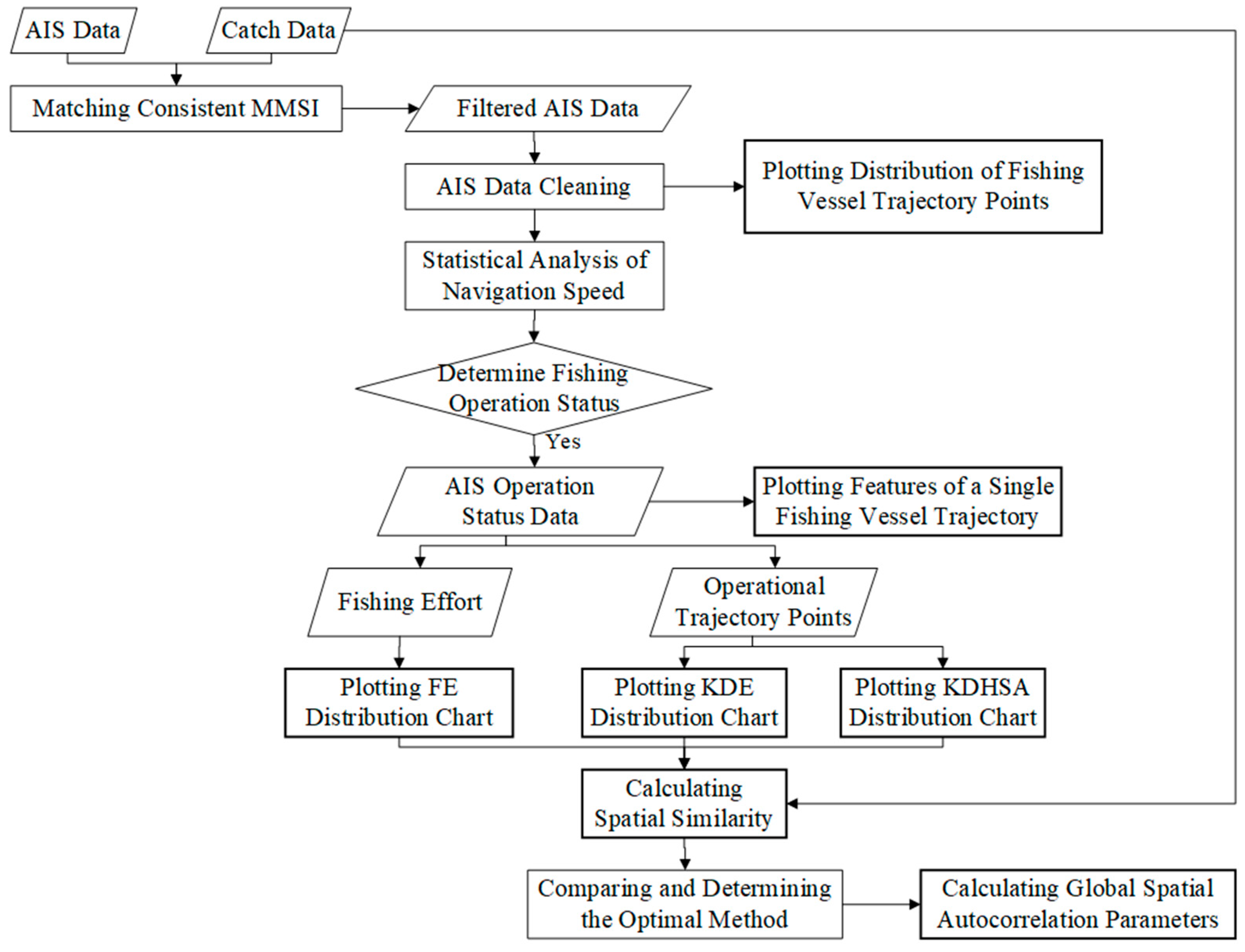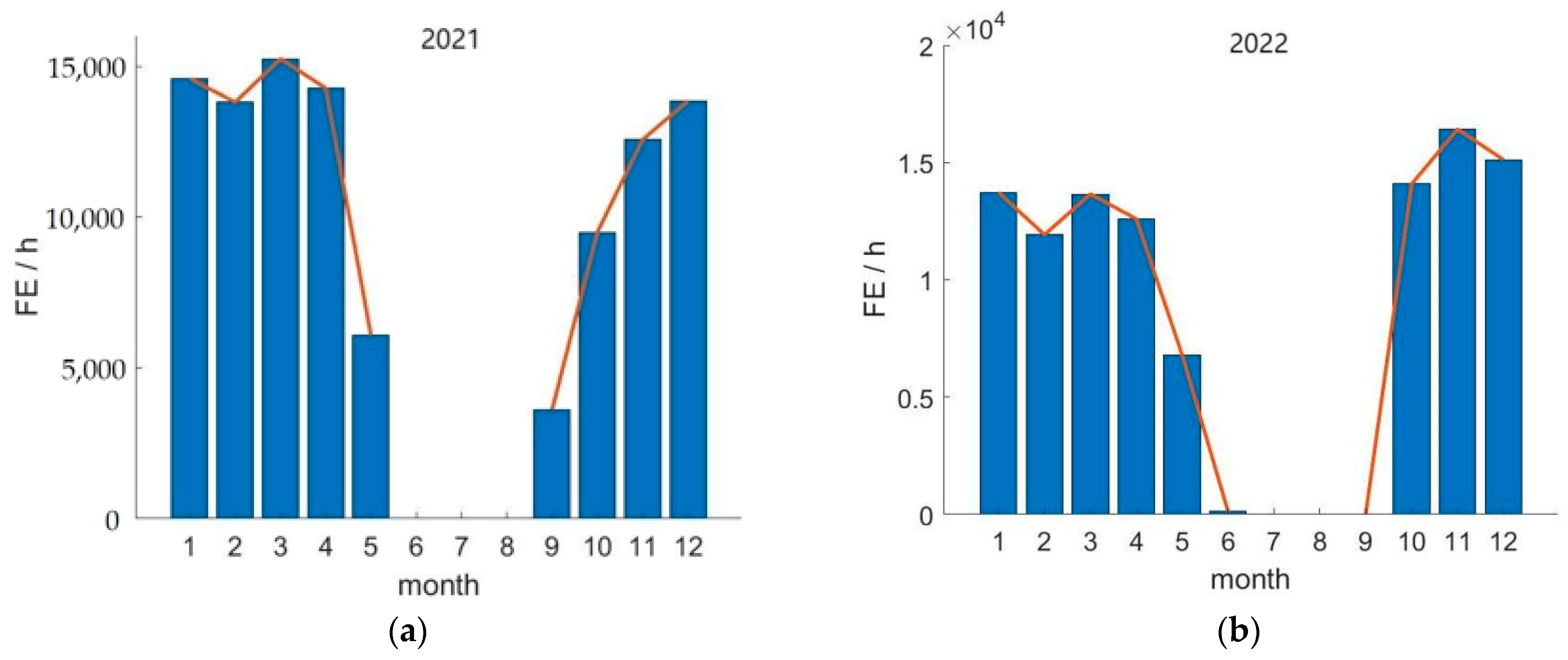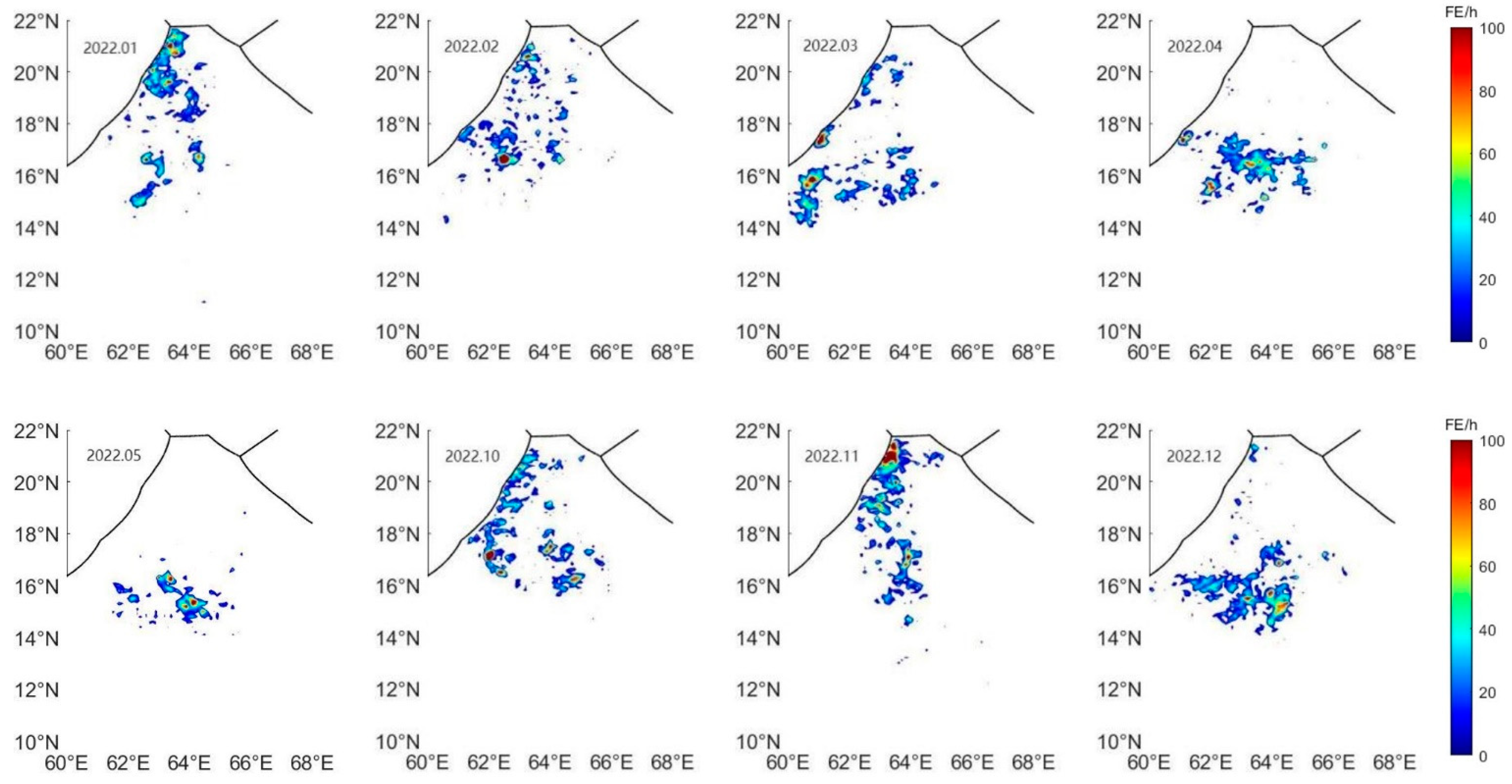Spatiotemporal Analysis of Light Purse Seine Fishing Vessel Operations in the Arabian High Seas Based on Automatic Identification System Data
Abstract
:1. Introduction
2. Materials and Methods
2.1. Data Sources and Processing
2.1.1. Data Sources
2.1.2. Data Processing
2.2. Methods
2.2.1. Technical Workflow
- The AIS data were compared with the relevant catch data and identity information of mainland China’s purse seine fishing vessels, and the AIS data corresponding to the MMSI numbers of the relevant fishing vessels were screened out.
- Data cleaning was conducted on the original AIS data following the method outlined in Section 2.1.2.
- The cleaned data were analyzed to identify AIS records indicating the fishing behavior of the fishing vessels and the trajectories of fishing vessel operations were extracted, which were visually represented as fishing vessel operation trajectories.
- Three methods, namely, fishing effort (FE), KDE, and kernel density hotspot analysis (KDHSA), were utilized to extract fishing grounds and subsequently, the results were compared and analyzed.
- The extraction results of the three methods were compared with the catch data, and a spatial similarity analysis was performed.
- The most effective method was determined and statistical analyses were conducted on the extracted fishery information, including global autocorrelation and other relevant parameters.
2.2.2. Operation Behavior of the Light Purse Seine Vessels
2.2.3. Identification of Fishing Vessel Operation Status
2.2.4. Kernel Density Estimation
2.2.5. Hotspot Analysis
2.2.6. Kernel Density Hotspot Analysis
2.2.7. Spatial Similarity Statistics
2.2.8. Global Moran’s Index
3. Results
3.1. Analysis of Fishing Vessel Speed
3.2. Analysis of Single Fishing Vessel Behavior
3.3. Spatial Distribution of Fishing Vessel Tracks
3.4. Comparison of the Mapping Results of Different Methods
3.5. Spatial Similarity Index
3.6. Characterization of the Spatial Distribution of Fishing Vessel Operations
3.7. Centre of Gravity of Fishing Vessel Operations
3.8. Global Spatial Pattern of Fishing Vessel Operations
4. Discussion
4.1. The Reliability of AIS Data
4.2. Fishing Vessel Operational Status Recognition
4.3. Comparison of the Three Methods for Extracting Spatial Information and Spatial Similarity Analysis
4.4. Spatial and Temporal Distribution of Fishing Vessel Operations
4.5. Implications for Fisheries Management
5. Conclusions
- The spatial distributions of fishing effort and kernel density were similar to the spatial layout of fishing grounds. The spatial similarity between fishing effort and catch data was the highest, with the use of a 0.25° spatial scale deemed most suitable for extracting and analyzing spatial information related to light purse seine fishing vessels in the Arabian Sea.
- The operational space of light purse seine fishing vessels in the Arabian Sea displayed patchy distribution characteristics and underwent significant spatial changes each month. There were evident seasonal variations with no apparent distribution pattern, emphasizing the need for detailed information in resource analysis and management within this region.
- AIS data were valuable for monitoring the operations of light purse seine fishing vessels in the Arabian Sea. Through real-time data supervision, it enhanced the monitoring of fishing ground distribution and fishing pressure, assisting in global resource conservation efforts. However, it is essential to integrate other technical methods for more effective supervision of fishing vessel operations.
Supplementary Materials
Author Contributions
Funding
Institutional Review Board Statement
Informed Consent Statement
Data Availability Statement
Acknowledgments
Conflicts of Interest
References
- Chen, R.; Wang, Y.; Wu, X.; Gao, Z. Identifying the Key Factors Influencing Spatial and Temporal Variations of Regional Coastal Fishing Activities. Ocean Coast. Manag. 2024, 248, 106940. [Google Scholar] [CrossRef]
- Tickler, D.; Meeuwig, J.J.; Palomares, M.-L.; Pauly, D.; Zeller, D. Far from Home: Distance Patterns of Global Fishing Fleets. Sci. Adv. 2018, 4, eaar3279. [Google Scholar] [CrossRef] [PubMed]
- Xu, Z.; Wang, J.; Zhou, C.; Lei, L.; Chen, X.; Li, B. Identification of Fishing State of Purse Seine Fishing Vessels Based on Multi-Indices. J. Ocean. Univ. China 2023, 22, 1605–1612. [Google Scholar] [CrossRef]
- Mullié, W.C. Apparent Reduction of Illegal Trawler Fishing Effort in Ghana’s Inshore Exclusive Zone 2012–2018 as Revealed by Publicly Available AIS Data. Mar. Policy 2019, 108, 103623. [Google Scholar] [CrossRef]
- Cimino, M.A.; Anderson, M.; Schramek, T.; Merrifield, S.; Terrill, E.J. Towards a Fishing Pressure Prediction System for a Western Pacific EEZ. Sci. Rep. 2019, 9, 461. [Google Scholar] [CrossRef]
- Kroodsma, D.A.; Mayorga, J.; Hochberg, T.; Miller, N.A.; Boerder, K.; Ferretti, F.; Wilson, A.; Bergman, B.; White, T.D.; Block, B.A.; et al. Tracking the Global Footprint of Fisheries. Science 2018, 359, 904–908. [Google Scholar] [CrossRef]
- Vespe, M.; Gibin, M.; Alessandrini, A.; Natale, F.; Mazzarella, F.; Osio, G.C. Mapping EU Fishing Activities Using Ship Tracking Data. J. Maps 2016, 12, 520–525. [Google Scholar] [CrossRef]
- Russo, E.; Monti, M.A.; Mangano, M.C.; Raffaetà, A.; Sarà, G.; Silvestri, C.; Pranovi, F. Temporal and Spatial Patterns of Trawl Fishing Activities in the Adriatic Sea (Central Mediterranean Sea, GSA17). Ocean Coast. Manag. 2020, 192, 105231. [Google Scholar] [CrossRef]
- Yan, Z.; He, R.; Ruan, X.; Yang, H. Footprints of Fishing Vessels in Chinese Waters Based on Automatic Identification System Data. J. Sea Res. 2022, 187, 102255. [Google Scholar] [CrossRef]
- James, M.; Mendo, T.; Jones, E.L.; Orr, K.; McKnight, A.; Thompson, J. AIS Data to Inform Small Scale Fisheries Management and Marine Spatial Planning. Mar. Policy 2018, 91, 113–121. [Google Scholar] [CrossRef]
- Wang, Y.B.; Wang, Y. Estimating Catches with Automatic Identification System (AIS) Data: A Case Study of Single Otter Trawl in Zhoushan Fishing Ground, China. Iran. J. Fish. Sci. 2016, 15, 75–90. [Google Scholar]
- Lee, J.; South, A.B.; Jennings, S. Developing Reliable, Repeatable, and Accessible Methods to Provide High-Resolution Estimates of Fishing-Effort Distributions from Vessel Monitoring System (VMS) Data. ICES J. Mar. Sci. 2010, 67, 1260–1271. [Google Scholar] [CrossRef]
- Sun, Y.-W.; Zhang, S.-M.; Tang, F.-H.; Wang, S.-X.; Fan, W.; Fan, X.-M.; Yang, S.-L. Research on the Distribution and Types of Fishing Vessels in the North Pacific Based on Satellite Ship Position Data. J. Agric. Sci. Technol. 2022, 24, 207–217. [Google Scholar]
- Le Guyader, D.; Ray, C.; Gourmelon, F.; Brosset, D. Defining High-Resolution Dredge Fishing Grounds with Automatic Identification System (AIS) Data. Aquat. Living Resour. 2017, 30, 39. [Google Scholar] [CrossRef]
- Chen, R.; Wu, X.; Liu, B.; Wang, Y.; Gao, Z. Mapping Coastal Fishing Grounds and Assessing the Effectiveness of Fishery Regulation Measures with AIS Data: A Case Study of the Sea Area around the Bohai Strait, China. Ocean Coast. Manag. 2022, 223, 106136. [Google Scholar] [CrossRef]
- Darasi, F.; Aksissou, M. Longline, Trawl, and Purse Seine in Coastal Fishing of Tangier Port in North-West of Morocco. Egypt. J. Aquat. Res. 2019, 45, 381–388. [Google Scholar] [CrossRef]
- Xiao, G.; Xu, B.; Zhang, H.; Tang, F.H.; Chen, F.; Zhu, W.B. A Study on Spatial-Temporal Distribution and Marine Environmental Elements of Symplectoteuthis Oualaniensis Fishing Grounds in Outer Sea of Arabian Sea. S. China Fish. Sci. 2022, 18, 10–19. [Google Scholar]
- Yang, S.-L.; Fan, X.-M.; Wu, Y.-M.; Zhou, W.-F.; Wang, F.; Wu, Z.-L.; Zhang, B.-B.; Fan, W. The Relationship between the Fishing Ground of Mackerel (Scomber australasicus) in Ara Bian Sea and the Environment Based on GAM Model. Chin. J. Ecol. 2019, 38, 2466. [Google Scholar]
- Yang, S.-L.; Fan, X.-M.; Zhang, B.-B.; Zhang, H.; Zhang, S.-M.; Cui, X.-S. Spatial-Temporal Distribution of Purse Seine in Arabian Sea and Its Relationship with Sea Surface Environmental Factors. J. Agric. Sci. Technol. 2019, 21, 149–158. [Google Scholar]
- Fan, X.-M.; Cui, X.-S.; Tang, F.-H.; Fan, W.; Wu, Y.-M.; Zhang, H. Research on the Prediction Model of Spatial Distribution of Sthenoteuthis Oualaniensis in the Open Sen Arabian Sea Based on PCA-GAM. J. Fish. China 2022, 46, 2340–2348. [Google Scholar]
- Taconet, M.; Kroodsma, D.; Fernandes, J.A. Global Atlas of AIS-Based Fishing Activity—Challenges and Opportunities; FAO: Rome, Italy, 2019. [Google Scholar]
- Wan, L.; Cheng, T.; Fan, W.; Shi, Y.; Zhang, H.; Zhang, S.; Yu, L.; Dai, Y.; Yang, S. Spatial Information Extraction of Fishing Grounds for Light Purse Seine Vessels in the Northwest Pacific Ocean Based on AIS Data. Heliyon 2024, 10, e28953. [Google Scholar] [CrossRef] [PubMed]
- Warren, D.L.; Glor, R.E.; Turelli, M. Environmental Niche Equivalency versus Conservatism: Quantitative Approaches to Niche Evolution. Evolution 2008, 62, 2868–2883. [Google Scholar] [CrossRef] [PubMed]
- Debrah, E.A.; Wiafe, G.; Agyekum, K.A.; Aheto, D.W. An Assessment of the Potential for Mapping Fishing Zones off the Coast of Ghana Using Ocean Forecast Data and Vessel Movement. West Afr. J. Appl. Ecol. 2018, 26, 26–43. [Google Scholar]
- Bez, N.; Walker, E.; Gaertner, D.; Rivoirard, J.; Gaspar, P. Fishing Activity of Tuna Purse Seiners Estimated from Vessel Monitoring System (VMS) Data. Can. J. Fish. Aquat. Sci. 2011, 68, 1998–2010. [Google Scholar] [CrossRef]
- Borruso, G. Network Density Estimation: A GIS Approach for Analysing Point Patterns in a Network Space. Trans. GIS 2008, 12, 377–402. [Google Scholar] [CrossRef]
- Feng, Y.; Chen, X.; Gao, F.; Liu, Y. Impacts of Changing Scale on Getis-Ord Gi* Hotspots of CPUE: A Case Study of the Neon Flying Squid (Ommastrephes bartramii) in the Northwest Pacific Ocean. Acta Oceanol. Sin. 2018, 37, 67–76. [Google Scholar] [CrossRef]
- Yang, S.; Wang, L.; Fei, Y.; Zhang, S.; Yu, L.; Zhang, H.; Wang, F.; Wu, Y.; Wu, Z.; Wang, W.; et al. Spatio-Temporal Variability of Fishing Habitat Suitability to Tuna Purse Seine Fleet in the Western and Central Pacific Ocean. Reg. Stud. Mar. Sci. 2024, 70, 103366. [Google Scholar] [CrossRef]
- Roberts, C.M.; McClean, C.J.; Veron, J.E.N.; Hawkins, J.P.; Allen, G.R.; McAllister, D.E.; Mittermeier, C.G.; Schueler, F.W.; Spalding, M.; Wells, F.; et al. Marine Biodiversity Hotspots and Conservation Priorities for Tropical Reefs. Science 2002, 295, 1280–1284. [Google Scholar] [CrossRef]
- Bernabé, P.; Gotlieb, A.; Legeard, B.; Marijan, D.; Sem-Jacobsen, F.O.; Spieker, H. Detecting Intentional AIS Shutdown in Open Sea Maritime Surveillance Using Self-Supervised Deep Learning. IEEE Trans. Intell. Transp. Syst. 2024, 25, 1166–1177. [Google Scholar] [CrossRef]
- Welch, H.; Clavelle, T.; White, T.D.; Cimino, M.A.; Kroodsma, D.; Hazen, E.L. Unseen Overlap between Fishing Vessels and Top Predators in the Northeast Pacific. Sci. Adv. 2024, 10, eadl5528. [Google Scholar] [CrossRef]
- Seto, K.L.; Miller, N.A.; Kroodsma, D.; Hanich, Q.; Miyahara, M.; Saito, R.; Boerder, K.; Tsuda, M.; Oozeki, Y.; Urrutia, S.O. Fishing through the Cracks: The Unregulated Nature of Global Squid Fisheries. Sci. Adv. 2023, 9, eadd8125. [Google Scholar] [CrossRef]
- Iacarella, J.C.; Burke, L.; Clyde, G.; Wicks, A.; Clavelle, T.; Dunham, A.; Rubidge, E.; Woods, P. Application of AIS-and Flyover-Based Methods to Monitor Illegal and Legal Fishing in Canada’s Pacific Marine Conservation Areas. Conserv. Sci. Pract. 2023, 5, e12926. [Google Scholar] [CrossRef]










| Method | Jan. | Feb. | Mar. | Apr. | May | Oct. | Nov. | Dec. |
|---|---|---|---|---|---|---|---|---|
| FE | 0.7 | 0.7 | 0.76 | 0.71 | 0.65 | 0.75 | 0.76 | 0.74 |
| KDE | 0.7 | 0.69 | 0.74 | 0.71 | 0.65 | 0.46 | 0.72 | 0.7 |
| KDHSA | 0.59 | 0.55 | 0.59 | 0.56 | 0.52 | 0.69 | 0.54 | 0.52 |
| Method | Jan. | Feb. | Mar. | Apr. | May | Oct. | Nov. | Dec. |
|---|---|---|---|---|---|---|---|---|
| FE | 0.71 | 0.73 | 0.75 | 0.73 | 0.69 | 0.78 | 0.79 | 0.77 |
| KDE | 0.69 | 0.71 | 0.74 | 0.69 | 0.68 | 0.69 | 0.68 | 0.72 |
| KDHSA | 0.62 | 0.64 | 0.71 | 0.67 | 0.68 | 0.63 | 0.6 | 0.66 |
Disclaimer/Publisher’s Note: The statements, opinions and data contained in all publications are solely those of the individual author(s) and contributor(s) and not of MDPI and/or the editor(s). MDPI and/or the editor(s) disclaim responsibility for any injury to people or property resulting from any ideas, methods, instructions or products referred to in the content. |
© 2024 by the authors. Licensee MDPI, Basel, Switzerland. This article is an open access article distributed under the terms and conditions of the Creative Commons Attribution (CC BY) license (https://creativecommons.org/licenses/by/4.0/).
Share and Cite
Yang, S.; Yu, L.; Jiang, K.; Fan, X.; Wan, L.; Fan, W.; Zhang, H. Spatiotemporal Analysis of Light Purse Seine Fishing Vessel Operations in the Arabian High Seas Based on Automatic Identification System Data. Appl. Sci. 2024, 14, 10692. https://doi.org/10.3390/app142210692
Yang S, Yu L, Jiang K, Fan X, Wan L, Fan W, Zhang H. Spatiotemporal Analysis of Light Purse Seine Fishing Vessel Operations in the Arabian High Seas Based on Automatic Identification System Data. Applied Sciences. 2024; 14(22):10692. https://doi.org/10.3390/app142210692
Chicago/Turabian StyleYang, Shenglong, Linlin Yu, Keji Jiang, Xiumei Fan, Lijun Wan, Wei Fan, and Heng Zhang. 2024. "Spatiotemporal Analysis of Light Purse Seine Fishing Vessel Operations in the Arabian High Seas Based on Automatic Identification System Data" Applied Sciences 14, no. 22: 10692. https://doi.org/10.3390/app142210692
APA StyleYang, S., Yu, L., Jiang, K., Fan, X., Wan, L., Fan, W., & Zhang, H. (2024). Spatiotemporal Analysis of Light Purse Seine Fishing Vessel Operations in the Arabian High Seas Based on Automatic Identification System Data. Applied Sciences, 14(22), 10692. https://doi.org/10.3390/app142210692







